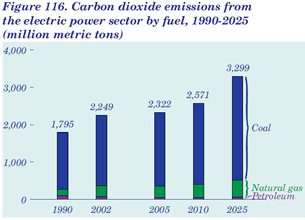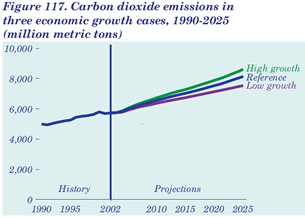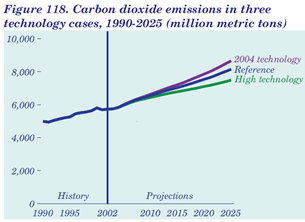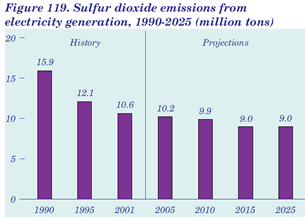|
Annual Energy Outlook 2004 with Projections to 2025 Market Trends - Carbon Dioxide Emissions Index (click to jump links) Higher Energy Consumption Forecast Increases Carbon Dioxide Emissions
Carbon dioxide emissions from energy use are projected to increase on average by 1.5 percent per year from 2002 to 2025, to 8,142 million metric tons (Figure 115). Emissions per capita are projected to grow by 0.7 percent per year from 2002 to 2025. Carbon dioxide emissions in the residential sector, including emissions from the generation of electricity used in the sector, are projected to increase by an average of 1.1 percent per year, reflecting increased electrification and penetration of computers, electronics, and appliances in the sector. Significant growth in office equipment and computers, as well as floorspace, is also projected for the commercial sector. As a result, carbon dioxide emissions from the commercial sector are projected to increase by 1.9 percent per year from 2002 to 2025. Industrial emissions are projected to grow by 1.1 percent per year, as shifts to less energy-intensive industries and efficiency gains help to moderate growth in energy use. In the transportation sector, carbon dioxide emissions grow at an average annual rate of 1.9 percent. Increases in highway, rail, and air travel are partially offset by efficiency improvements in rail freight and aircraft, but passenger vehicle fuel economy is projected to increase only slightly above 2002 levels. In all sectors, potential growth in carbon dioxide emissions is expected to be moderated by efficiency standards, voluntary efficiency programs, and improvements in technology. Carbon dioxide mitigation programs, further improvements in technology, or more rapid adoption of voluntary programs could result in lower emissions levels than projected here. Electricity Generation Is a Major Source of Carbon Dioxide Emissions
The use of fossil fuels in the electric power industry accounted for 39 percent of total energy-related carbon dioxide emissions in 2002, and that share is projected to increase to 41 percent in 2025. Coal is projected to account for 55 percent of the power industry’s electricity generation in 2025 and 84 percent of electricity-related carbon dioxide emissions (Figure 116). In 2025, natural gas is projected to account for 20 percent of electricity generation but only 14 percent of electricity-related carbon dioxide emissions. From 2002 to 2025, the electric power industry is projected to retire 62 gigawatts of generating capacity—about 7 percent of the 2002 total—and to see a 49-percent increase in electricity sales. As a result, the industry is projected to add 317 gigawatts of new fossil-fueled capacity by 2025. Although much of the new capacity is expected to be relatively efficient combined-cycle plants fueled by natural gas, the net effect will be to raise the industry’s carbon dioxide emissions by 1,050 million metric tons, or 47 percent, from 2002 levels. The electric power industry is projected to increase its reliance on renewable energy, which generally does not contribute to carbon dioxide emissions. Renewable generation is expected to increase by 180 billion kilowatthours, or 53 percent, from 2002 to 2025, helping to offset the projected increase in carbon dioxide emissions from fossil fuels. Average carbon dioxide emissions per kilowatthour of total generation are projected to decline by about 2 percent from 2002 to 2010 and remain at about that level through 2025. Emissions Projections Change With Economic Growth Assumptions The high economic growth case assumes higher growth in population, labor force, and productivity than in the reference case, leading to higher industrial output, lower inflation, and lower interest rates. GDP growth in the high growth case averages 3.5 percent a year from 2002 to 2025, compared with 3.0 percent a year in the reference case. In the low economic growth case, GDP growth averages 2.4 percent per year.
Higher projections for manufacturing output and income increase the demand for energy services in the high economic growth case: projected energy consumption is 3 percent higher than in the reference case in 2010 and 7 percent higher in 2025. As a result, carbon dioxide emissions are projected to be 6 percent higher than in the reference case in 2025, at 8,615 million metric tons (Figure 117). Total energy intensity, measured as primary energy consumption per dollar of GDP, declines by 1.7 percent per year from 2002 to 2025 in the high growth case, as compared with 1.5 percent in the reference case. With more rapid projected growth in energy consumption, there is expected to be a greater opportunity for turnover in the stock of energy-using technologies, adding new equipment and increasing the overall efficiency of the capital stock. Projected total energy consumption is 3 percent lower in the low growth case than in the reference case in 2010 and 7 percent lower in 2025. Carbon dioxide emissions in 2025 are also 7 percent lower, at 7,538 million metric tons. Energy intensity is projected to decline at an average rate of 1.2 percent from 2002 to 2025 in the low economic growth case. Technology Advances Could Reduce Carbon Dioxide Emissions The reference case assumes continuing improvement in energy-consuming and producing technologies, consistent with historic trends, as a result of ongoing research and development. In the high technology case it is assumed that increased spending on research and development will result in earlier introduction, lower costs, and higher efficiencies for end-use technologies than assumed in the reference case. The costs and efficiencies of advanced fossil-fired and new renewable generating technologies are also assumed to improve from reference case values [120]. Energy intensity is expected to decline on average by 1.7 percent per year through 2025 in the high technology case, as compared with 1.5 percent in the reference case. As a result, energy consumption is projected to be 5 percent lower than in the reference case in 2025, at 129 quadrillion Btu, and carbon dioxide emissions are projected to be 8 percent lower than in the reference case, at 7,472 million metric tons (Figure 118). The 2004 technology case assumes that future equipment choices will be made from the equipment and vehicles available in 2004; that new building shell and plant efficiencies will remain at their 2004 levels; and that advanced generating technologies will not improve over time. Energy efficiency improves in the 2004 technology case as new equipment is chosen to replace older stock and the capital stock expands, and energy intensity declines by 1.3 percent per year from 2002 to 2025. Energy consumption reaches 143 quadrillion Btu in 2025 in the 2004 technology case, and carbon dioxide emissions in 2025 are projected to be 6 percent higher than in the reference case, at 8,654 million metric tons. Emissions from Electricity Generation Sulfur Dioxide Emissions Are Cut in Response to Tightening Regulations CAAA90 called for annual emissions of sulfur dioxide (SO2) by electricity generators in the power sector to be reduced to approximately 12 million tons in 1996, 9.48 million tons per year from 2000 to 2009, and 8.95 million tons per year thereafter. Because companies can bank allowances for future use, however, the long-term cap of 8.95 million tons per year is not expected to be reached until after 2014. More than 95 percent of the SO2 produced by generators results from coal combustion and the rest from residual oil. CAAA90 called for the reductions to occur in two phases, with larger (more than 100 megawatts) and higher emitting (more than 2.5 pounds per million Btu) plants making reductions first. In Phase 1, which began in 1995, 261 generating units at 110 plants were issued tradable emissions allowances that permitted their SO2 emissions to reach a fixed amount per year—generally less than the plant’s historical emissions. Allowances could also be banked for use in future years. Switching to lower sulfur subbituminous coal was the option chosen by most generators, and only about 12 gigawatts of capacity had been retrofitted with scrubbers by 1995.
In recent years, power companies have announced plans to add scrubbers to 23 gigawatts of capacity, in order to comply with State or Federal initiatives. Beyond those that have been announced, 2 gigawatts of additional capacity is projected to be retrofitted with scrubbers. Total SO2 emissions are projected to decline from 10.6 million tons in 2001 to 9.0 million tons in 2025 (Figure 119). The price of SO2 emission allowances is projected generally to range from $150 to $250 per ton between 2005 and 2025. Nitrogen Oxide Emissions Are Projected To Stay Below 2000 Levels Nitrogen oxide (NOx) emissions from electricity generation in the U.S. power sector are projected to fall as new regulations take effect (Figure 120). The required reductions are intended to reduce the formation of ground-level ozone, for which NOx emissions are a major precursor. Together with volatile organic compounds and hot weather, NOx emissions contribute to unhealthy air quality in many areas during the summer months. For several years, the EPA and the States have studied the movement of ozone from State to State. The States in the Northeast have argued that emissions from coal-fired power plants in the Midwest make it difficult for them to meet national air quality standards for ground-level ozone, and they have petitioned the EPA to force plant operators to reduce emissions by more than required under current rules. The Ozone Transport Rule called for capping NOx emissions in 22 Midwestern and Eastern States during the summer season, and following a court challenge, emissions limits were finalized for 19 States. The limits, included in the projections beginning in 2004, are projected to stimulate the addition of emissions control equipment to many existing plants, further lowering NOx emissions by 0.5 million tons between 2003 and 2004. After 2004, NOx emissions are projected to increase gradually, to 3.8 million tons in 2025. Overall, selective catalytic reduction equipment is projected to be added to approximately 92 gigawatts of capacity, and NOx allowance prices are projected to increase from roughly $4,000 per ton in 2004 to $5,500 per ton in 2025.
Released: January 2004 |





